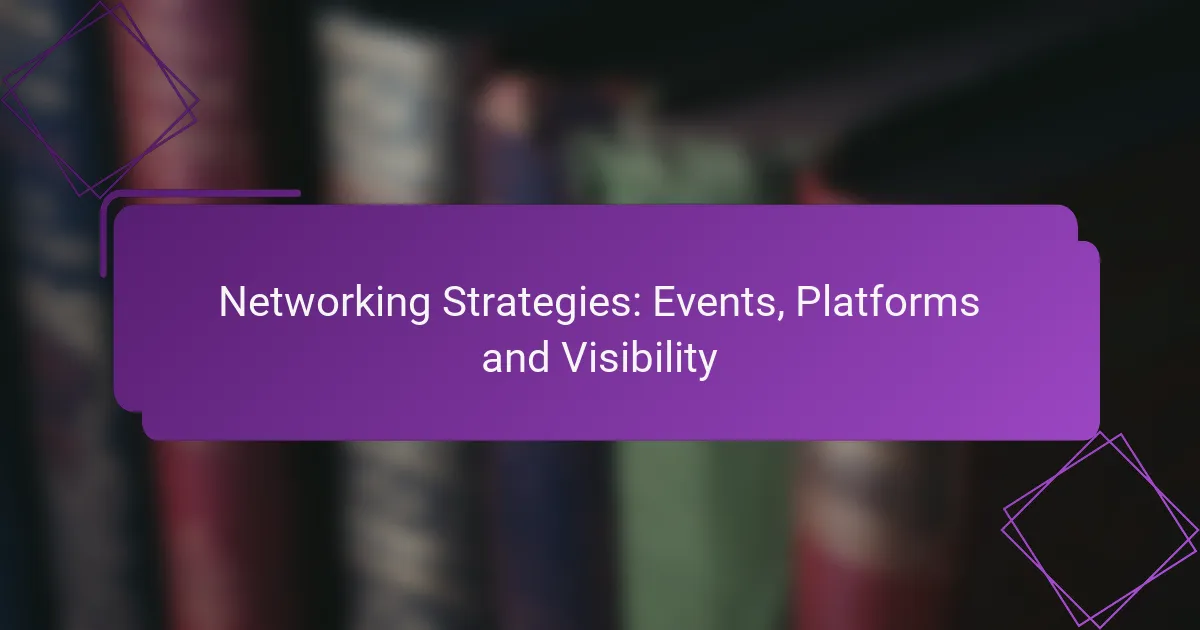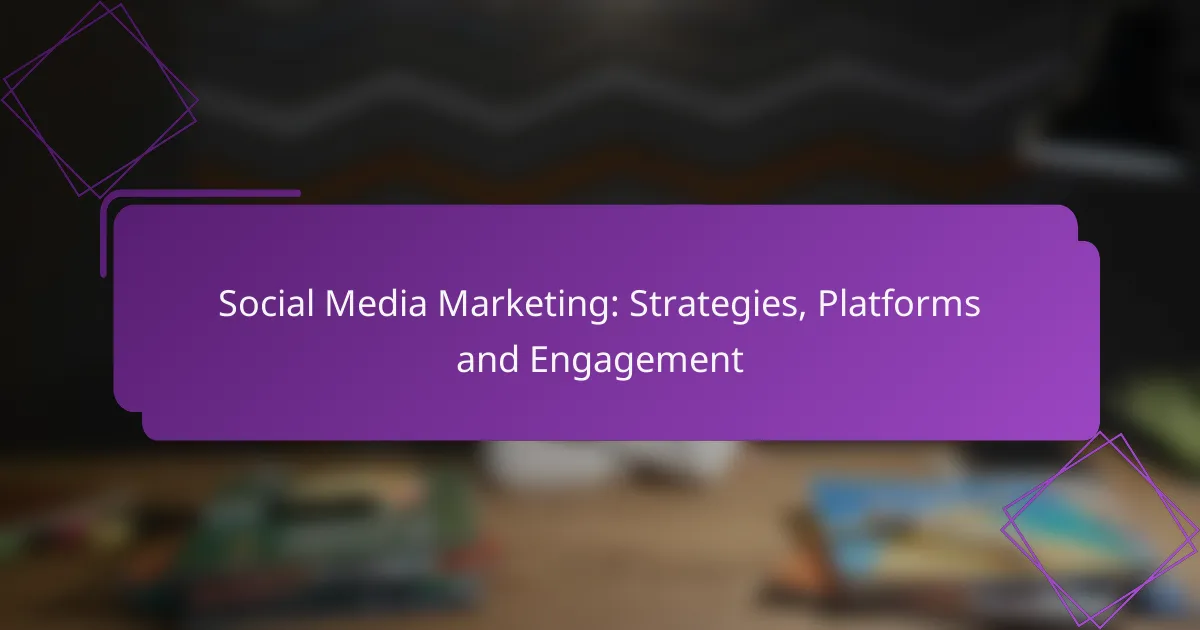Paid advertising offers a range of options for businesses looking to enhance their visibility and reach. Platforms like Google Ads, Facebook Ads, and Amazon Advertising each provide unique benefits in terms of cost, audience targeting, and overall effectiveness. Understanding the nuances of these options is essential for optimizing marketing strategies and achieving a strong return on investment.
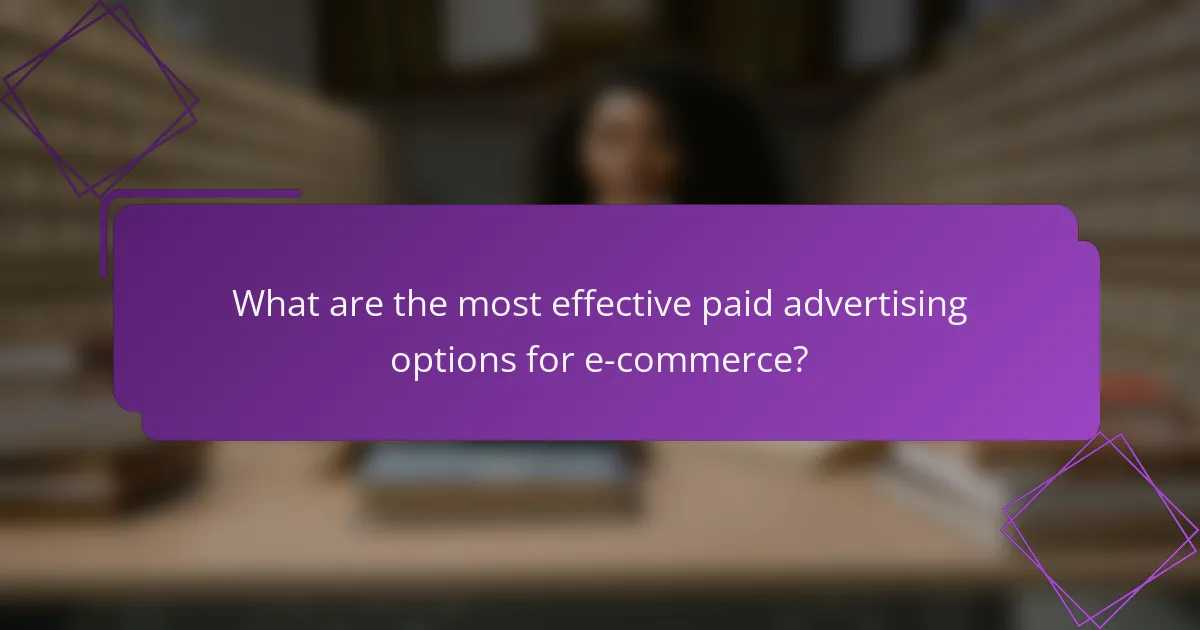
What are the most effective paid advertising options for e-commerce?
The most effective paid advertising options for e-commerce include Google Ads, Facebook Ads, Instagram Ads, Amazon Advertising, and LinkedIn Ads. Each platform offers unique advantages in terms of reach, targeting, and cost, making them suitable for different marketing strategies.
Google Ads
Google Ads allows businesses to display ads on Google’s search results and across its display network. This platform is effective for reaching potential customers actively searching for products, which can lead to high conversion rates.
When using Google Ads, consider targeting specific keywords related to your products. A well-structured campaign can yield a return on investment (ROI) ranging from 200% to 400%, depending on the industry and competition.
Facebook Ads
Facebook Ads enable businesses to target users based on demographics, interests, and behaviors. This platform is particularly useful for building brand awareness and engaging with potential customers through visually appealing content.
To maximize effectiveness, use A/B testing to determine which ad creatives resonate best with your audience. Average costs per click (CPC) can vary widely, typically ranging from $0.50 to $3.00, depending on your target market.
Instagram Ads
Instagram Ads leverage the visual nature of the platform to showcase products through images and videos. This format is ideal for e-commerce brands that rely on strong visual appeal to attract customers.
Utilizing Instagram Stories and shopping features can enhance user engagement. Expect to pay similar CPC rates as Facebook, with the added benefit of potentially higher engagement rates due to the platform’s younger audience.
Amazon Advertising
Amazon Advertising is tailored for sellers looking to promote their products directly on the Amazon marketplace. This platform is effective for driving sales as it targets users who are already in a buying mindset.
Consider using Sponsored Products or Sponsored Brands to increase visibility. Costs can vary based on competition, but many sellers see a significant increase in sales volume when utilizing Amazon’s advertising options.
LinkedIn Ads
LinkedIn Ads are designed for B2B marketing, allowing businesses to target professionals based on industry, job title, and company size. This platform is particularly effective for e-commerce brands selling to other businesses or professionals.
Utilize sponsored content or InMail campaigns to reach your audience effectively. While costs can be higher, often ranging from $2.00 to $7.00 per click, the quality of leads generated can justify the investment for B2B marketers.
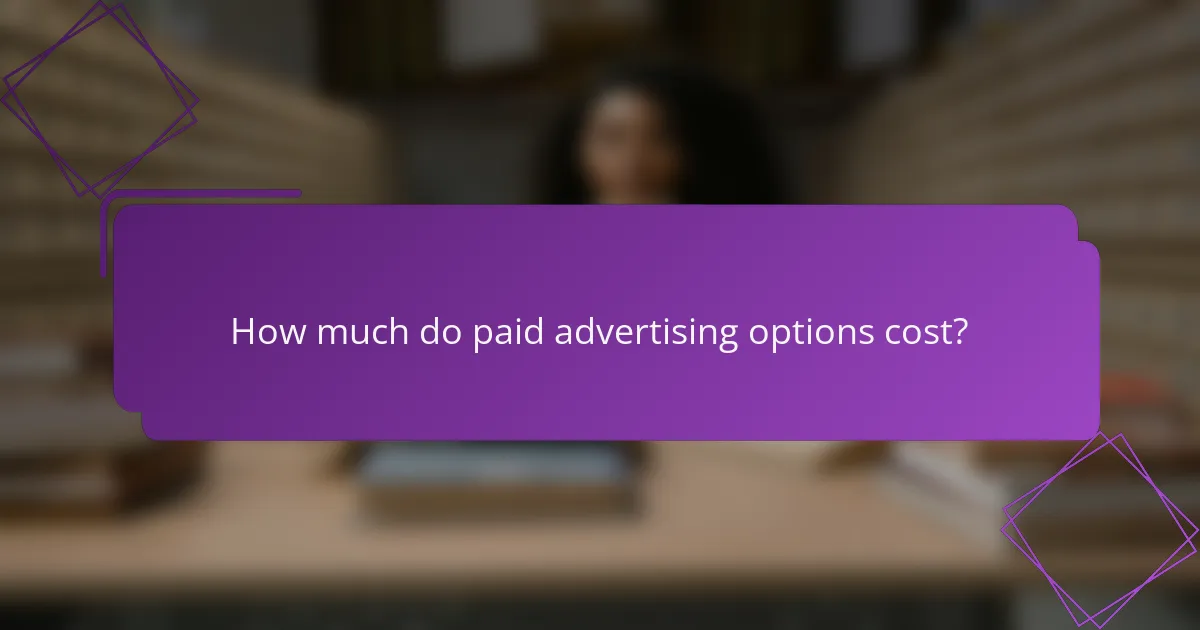
How much do paid advertising options cost?
Paid advertising costs vary significantly based on the platform, targeting options, and competition within your industry. Understanding these costs is crucial for budgeting and maximizing your return on investment.
Google Ads average CPC
The average cost-per-click (CPC) for Google Ads typically ranges from a few cents to several dollars, depending on the industry and competition. Highly competitive sectors, such as finance or legal services, may see CPCs in the low to mid double digits.
To manage costs effectively, set a clear budget and utilize Google’s bidding strategies, such as manual CPC or automated bidding. Regularly review and optimize your campaigns to improve performance and reduce unnecessary spending.
Facebook Ads pricing model
Facebook Ads operate on a bidding system where advertisers can choose between cost-per-click (CPC) or cost-per-impression (CPM) models. The average CPC can range from a few cents to a couple of dollars, while CPM typically falls between $5 and $15.
Consider your campaign goals when selecting a pricing model. For brand awareness, CPM may be more effective, while CPC is better suited for driving traffic. Regularly analyze ad performance to adjust bids and improve cost efficiency.
Instagram Ads cost per impression
Instagram Ads, which are managed through Facebook’s platform, usually have a CPM ranging from $5 to $10. However, costs can fluctuate based on audience targeting and ad placement.
To optimize your spending, focus on high-quality visuals and engaging content that resonates with your target audience. Monitor ad performance metrics to refine your strategy and ensure you are getting the best value for your impressions.
Amazon Advertising fees
Amazon Advertising fees vary based on the type of ads you choose, such as Sponsored Products or Sponsored Brands. The average CPC for Sponsored Products typically ranges from $0.20 to $2.00, depending on the product category and competition.
When advertising on Amazon, set a daily budget to control costs and use keyword targeting to reach relevant shoppers. Regularly analyze your campaigns and adjust bids based on performance to maximize your return on investment.
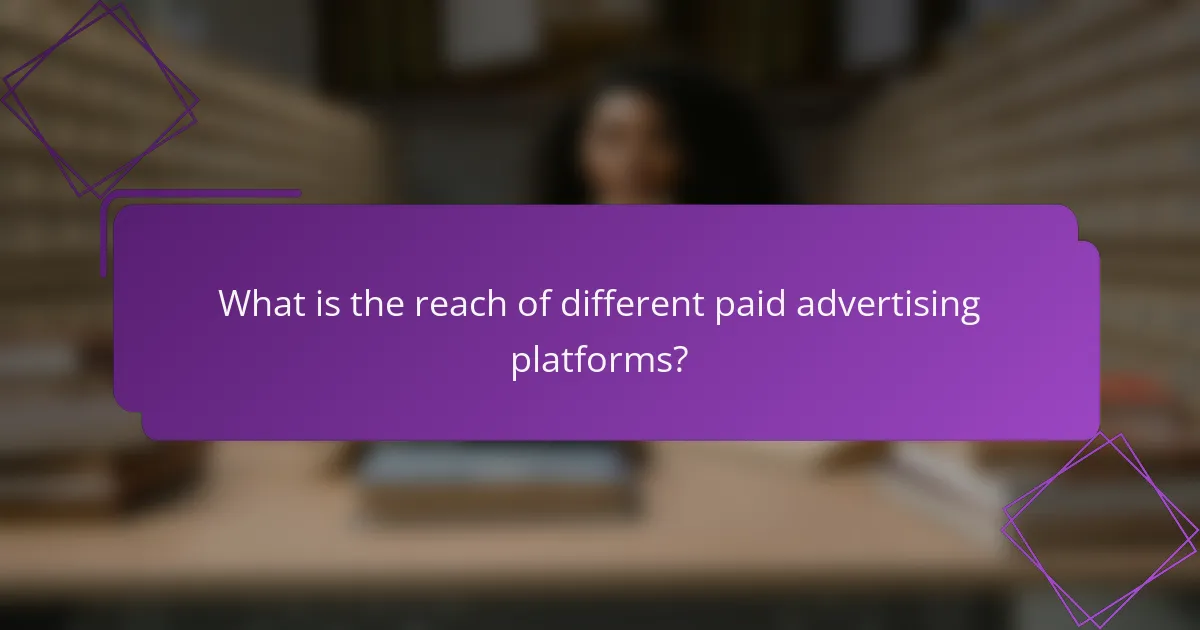
What is the reach of different paid advertising platforms?
The reach of various paid advertising platforms varies significantly, impacting how effectively businesses can connect with their target audiences. Understanding the audience reach of each platform helps in choosing the right one for specific marketing goals.
Google Ads audience reach
Google Ads offers extensive reach, targeting billions of users across search results and display networks. Advertisers can access a diverse audience, as Google processes over 3.5 billion searches daily, making it a powerful tool for businesses aiming to capture potential customers actively seeking products or services.
When using Google Ads, consider the type of campaign—search, display, shopping, or video—as each has different audience engagement levels. For instance, search ads often yield higher intent traffic, while display ads can enhance brand visibility across various websites.
Facebook Ads user demographics
Facebook Ads provides access to a vast user base, with over 2.8 billion monthly active users, allowing advertisers to target specific demographics effectively. The platform’s detailed targeting options enable businesses to reach users based on age, location, interests, and behaviors.
When creating Facebook Ads, leverage audience insights to refine targeting. For example, businesses can create lookalike audiences based on existing customer data, enhancing the chances of reaching potential customers who are likely to engage with their brand.
Instagram Ads engagement statistics
Instagram Ads boast high engagement rates, with users spending an average of 30 minutes daily on the platform. This visual-centric platform is particularly effective for brands in lifestyle, fashion, and beauty sectors, where compelling imagery can drive user interaction.
To maximize engagement, utilize Instagram’s features like Stories and Reels, which often receive higher visibility. Brands should focus on creating visually appealing content that resonates with their target audience to enhance interaction and conversion rates.
Amazon Advertising shopper insights
Amazon Advertising reaches millions of active shoppers, making it a prime platform for e-commerce businesses. With over 300 million customer accounts, advertisers can target users who are already in a buying mindset, leading to higher conversion rates.
Utilize Amazon’s various ad formats, such as Sponsored Products and Sponsored Brands, to increase visibility on product search results. Understanding shopper behavior on Amazon can help tailor campaigns to meet customer needs, ultimately driving sales and brand loyalty.
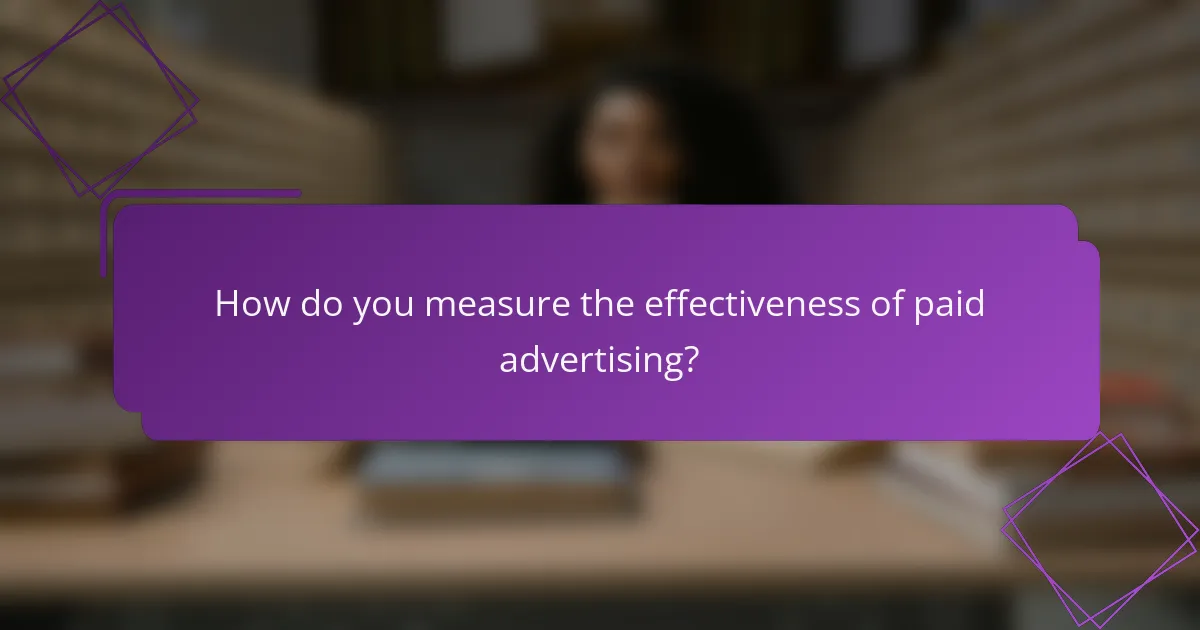
How do you measure the effectiveness of paid advertising?
Measuring the effectiveness of paid advertising involves analyzing various metrics that indicate how well your ads perform in achieving their goals. Key performance indicators (KPIs) such as Return on Ad Spend (ROAS), Click-Through Rate (CTR), and Conversion Rate provide insights into the financial and engagement aspects of your campaigns.
Return on Ad Spend (ROAS)
Return on Ad Spend (ROAS) measures the revenue generated for every dollar spent on advertising. A common benchmark for a successful campaign is a ROAS of at least 4:1, meaning for every $1 spent, $4 in revenue is generated. This metric helps advertisers understand the profitability of their campaigns.
To calculate ROAS, divide the total revenue from ads by the total ad spend. For example, if you spent $1,000 on ads and generated $5,000 in revenue, your ROAS would be 5:1. Regularly monitoring this metric allows for adjustments in strategy to maximize returns.
Click-Through Rate (CTR)
Click-Through Rate (CTR) indicates the percentage of people who clicked on your ad after seeing it. A higher CTR suggests that your ad is relevant and engaging to your target audience. Typical CTRs vary by industry but generally range from 1% to 5% for most online ads.
To calculate CTR, divide the number of clicks by the number of impressions and multiply by 100. For instance, if your ad received 200 clicks from 10,000 impressions, your CTR would be 2%. Improving your ad copy and visuals can help boost this metric.
Conversion Rate analysis
Conversion Rate measures the percentage of users who take a desired action after clicking on your ad, such as making a purchase or signing up for a newsletter. A good conversion rate typically falls between 2% and 5%, but this can vary significantly based on the industry and the type of conversion.
To analyze conversion rates, divide the number of conversions by the total number of visitors who clicked on your ad. For example, if 50 out of 1,000 visitors converted, your conversion rate would be 5%. Focus on optimizing landing pages and user experience to enhance this metric.
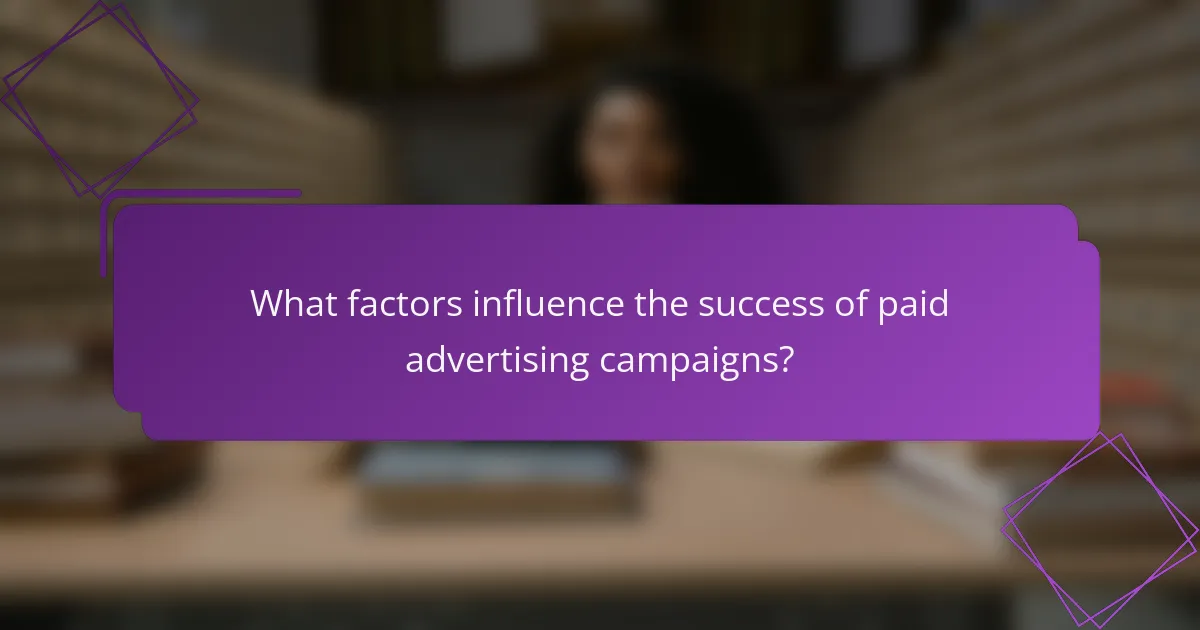
What factors influence the success of paid advertising campaigns?
The success of paid advertising campaigns is influenced by several key factors, including target audience selection, ad placement, budget allocation, and message relevance. Understanding these elements helps advertisers optimize their strategies for better reach and effectiveness.
Target audience selection
Choosing the right target audience is crucial for the success of paid advertising campaigns. Advertisers should define their ideal customer profiles based on demographics, interests, and behaviors to ensure their ads reach the most relevant viewers.
Utilizing tools like social media insights and market research can help identify potential audience segments. For example, a campaign targeting young adults may focus on platforms like Instagram or TikTok, while a campaign aimed at professionals might perform better on LinkedIn.
Common pitfalls include targeting too broadly or too narrowly. A well-defined audience can improve engagement rates, while a poorly defined one can lead to wasted ad spend. Regularly reviewing and adjusting audience parameters based on campaign performance is essential for maintaining effectiveness.

